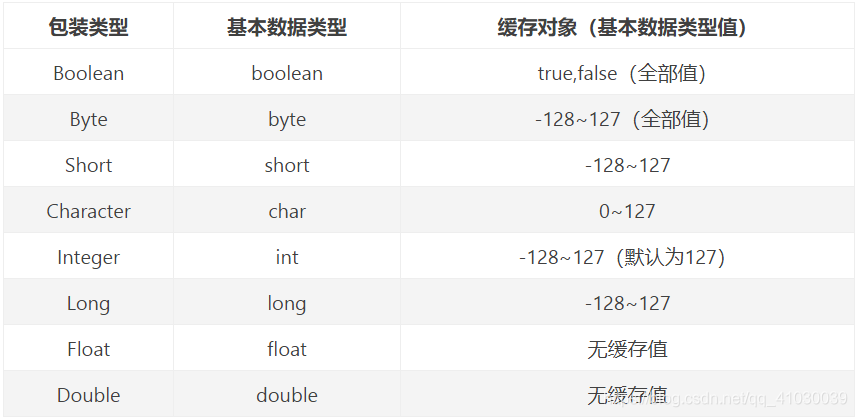一、装箱和拆箱
原始类型转换为对象类型就是装箱,反之就是拆箱。
原始类型byte,short,char,int,long,float,double,boolean对应的封装类为Byte,Shor,Character,Integer,Long,Float,Double,Boolean.
二、源码解读
自动装箱时编译器调用valueOf将原始类型值转换成对象,同时自动拆箱时,编译器通过调用类似intValue(),doubleValue()这类的方法将对象转换成原始类型值。
以Integer的自动装箱为例:
public static Integer valueOf(int i) {
//判断i是否在-128和127之间,存在则从IntegerCache中获取包装类的实例,否则new一个新实例
if (i >= IntegerCache.low && i <= IntegerCache.high)
return IntegerCache.cache[i + (-IntegerCache.low)];
return new Integer(i);
}
//使用亨元模式,来减少对象的创建(亨元设计模式大家有必要了解一下,我认为是最简单的设计模式,也许大家经常在项目中使用,不知道他的名字而已)
private static class IntegerCache {
static final int low = -128;
static final int high;
static final Integer cache[];
//静态方法,类加载的时候进行初始化cache[],静态变量存放在常量池中
static {
// high value may be configured by property
int h = 127;
String integerCacheHighPropValue =
sun.misc.VM.getSavedProperty("java.lang.Integer.IntegerCache.high");
if (integerCacheHighPropValue != null) {
try {
int i = parseInt(integerCacheHighPropValue);
i = Math.max(i, 127);
// Maximum array size is Integer.MAX_VALUE
h = Math.min(i, Integer.MAX_VALUE - (-low) -1);
} catch( NumberFormatException nfe) {
// If the property cannot be parsed into an int, ignore it.
}
}
high = h;
cache = new Integer[(high - low) + 1];
int j = low;
for(int k = 0; k < cache.length; k++)
cache[k] = new Integer(j++);
// range [-128, 127] must be interned (JLS7 5.1.7)
assert IntegerCache.high >= 127;
}
private IntegerCache() {}
}
Integer i = 40;相当于调用了Integer.valueOf(40)方法:
首先判断i是否在-128和127之间,如果在,直接从IntegerCache缓存中获取指定数字的包装类;不存在则new出一个新的包装类。
IntegerCache内部实现了一个Integer的静态常量数组,在类加载的时候,执行static静态代码块进行初始化-128到127之间的Integer对象,存到cache数组中。cache属于常量,存放在Java的方法区中。
这就解释了以下的结果:
Integer i = 40;
Integer j = 40;
Integer k = 200;
i == j 为true;
i == k 为false;
Integer i4 = new Integer(40);
Integer i5 = new Integer(40);
Integer i6 = new Integer(0);
i4 == i5 为false,因为直接new,地址不同
i4 == i5+i6 为true,因为涉及到缓存。
Java8种基本类型的自动装箱源码:
//boolean原生类型自动装箱成Boolean
public static Boolean valueOf(boolean b) {
return (b ? TRUE : FALSE);
}
//byte原生类型自动装箱成Byte
public static Byte valueOf(byte b) {
final int offset = 128;
return ByteCache.cache[(int)b + offset];
}
//byte原生类型自动装箱成Byte
public static Short valueOf(short s) {
final int offset = 128;
int sAsInt = s;
if (sAsInt >= -128 && sAsInt <= 127) { // must cache
return ShortCache.cache[sAsInt + offset];
}
return new Short(s);
}
//char原生类型自动装箱成Character
public static Character valueOf(char c) {
if (c <= 127) { // must cache
return CharacterCache.cache[(int)c];
}
return new Character(c);
}
//int原生类型自动装箱成Integer
public static Integer valueOf(int i) {
if (i >= IntegerCache.low && i <= IntegerCache.high)
return IntegerCache.cache[i + (-IntegerCache.low)];
return new Integer(i);
}
//int原生类型自动装箱成Long
public static Long valueOf(long l) {
final int offset = 128;
if (l >= -128 && l <= 127) { // will cache
return LongCache.cache[(int)l + offset];
}
return new Long(l);
}
//double原生类型自动装箱成Double
public static Double valueOf(double d) {
return new Double(d);
}
//float原生类型自动装箱成Float
public static Float valueOf(float f) {
return new Float(f);
}
通过源码分析,只有double和float没有使用缓存,每次都是new一个新对象。
使用缓存的策略是因为缓存的这些对象都是经常使用到的,防止每次自动装箱都创建一次对象的实例。
缓存对象的范围:
